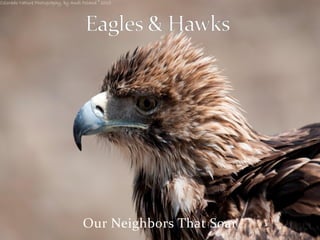
Soaring Neighbors: Golden Eagles and Red-tailed Hawks
- 1. Our Neighbors That Soar
- 2. Golden Eagle Red-tailed Hawk
- 3. Extraordinarily Adaptable Live in all habitats Variety of colors/morphs Most common hawk in N.A.
- 4. Tolerant to humans & human activity 2014 Red-tailed Hawk in the Backcountry Red-tailed pair nesting in Central Park, NYC.
- 5. Not tolerant to humans and human activity Nest in cliffs or tall trees with unobstructed views Avoid urban habitat Disturbances can lead to reproductive failure 2011 USFWS population survey estimated 30,000 G.E. in lower 48 70% of deaths are due to human impact
- 6. Records describe a pair of eagles nesting on Wildcat Mountain in the 1920’s and 30’s.
- 7. Pictures of the 1937 clutch.
- 8. Biologists built a blind on the cliff side. The X marks the nest locaiton.
- 10. Development occurred over time and encroached on the eagles’ home range. Rabbit and prairie dog colonies were destroyed – their main dietary components. Reduction of food along with development pressures are likely what caused the eagles to leave.
- 11. The cliffs were uninhabited by eagles for roughly 70 years.
- 12. Why did they return? 2010 eagles returned – not to the same nesting site. The one used in the 1920’s was too close to homes and human impacts.
- 13. 2000 conservation survey labeled the cliff area as “best wildlife habitat”. From 2006-09 trail systems were built around the cliffs.
- 14. Trail follows the road to provide the least amount of disturbance to habitat and wildlife. Trail Designw/ Conservation in Mind In designing the Douglas County East West Trail, the trail runs along Monarch Blvd and as far away from the cliffs as possible to reduce disturbance. This concept is why we don’t create a mass trail system in the Backcountry.
- 15. Conservation efforts in mind Part of the Backcountry Wilderness Area 8,200 acres of conservation space Federally Protected by Law Migratory Bird Treaty Act Lacey Act Bald & Golden Eagle Protection Act – 1962 Illegal to “pressure, shoot, shoot at, poison, wound, kill, capture, trap, collect, destroy, molest, disturb”
- 16. As simple as a change in heart rate As obvious as fight or flight behavior Consider that when you’re hiking, whether you realize it or not, you’re influencing the behavior of the wildlife around you. If you spook a rabbit, you’re affecting the behavior of a prey species which in turn affects the behavior of the predator. Eagles are not the only bird species in the area that are sensitive to humans. Mountain bluebirds and spotted towhees are sensitive to human activity which is why we see them in the Backcountry versus your backyard.
- 17. Trespassing into the protected area is a felony offense and one can be fined up to $250,000 and face jail time.
- 18. Talon, the 2014 eaglet When we obey the laws and keep conservation in mind when designing communities and trails, we see results. The eagles stay and successfully raise their young. The bonded pair that now nests on Wildcat Mountain has nested there for 5 years and had two successful clutches. It takes around 40-45 days to incubate.
- 20. We banded the eaglet through a licensed bander. By three weeks old, their legs are as thick as they will be as an adult making it safe to band. This allows researchers to collect data on the age and origin of the individual. Notice from the sterile egg just how much the animal has grown in only three weeks.
- 21. Juvenile Golden Eagles often have white feathers. They will be sexually mature by four years old.
- 24. Golden Eagles primary food sources are rabbits, hares, and prairie dogs, but they are capable of killing large prey such as domestic livestock, cranes, and deer.
- 25. Because they eat mostly mammals, Golden Eagles have largely avoided population declines due to pesticides unlike other fish or bird eating raptors such as the Bald Eagle.
- 26. A female eagle weighs 30% more than a male, but still only checks in between 9-15 pounds. With a 7 foot wingspan, this large predator has been clocked diving at 200 mph.
- 27. Their talons can be up to 3 inches long and can exert 450-750 psi of pressure when squeezing.
- 28. Golden Eagles can live 20-25 years in the wild and become sexually mature between ages 4-5. They are monogamous and will often return to the same nesting site each year. Females typically lay 1-3 eggs each year.
- 29. 70-80% of Golden Eagles die before age 5. This is mostly due to conflicts with humans.
- 30. We’re proud to take part in protecting these beautiful and powerful creatures.
- 31. Colorado Nature Photography, by Andi Poland The Raptor Education Foundation The Price Family Oregon Public Broadcasting Cornell Lab of Ornithology Palemale.com Huffington Post Simply-san-juan.com Pinterest Laura Meyers Photography Garrick Fields Drew Martin Photography CaptiveLight.biz The PlanetD The Dirt Doctor Fort Collins Science Center Edwin Giesbers / Minden Pictures National Park Service Jacqueline Deely